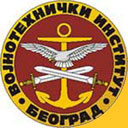 |
SCIENTIFIC-TECHNICAL INFORMATION Military Technical Institute Belgrade |
|||
|
SERBIA |
FRANCIA |
|||

|
ADDENDUM TO NUMERICAL SIMULATION AND OPTIMIZATION OF ROTATIONAL LIFTING SURFACES
Jelena Svorcan
Abstrakt: The subjects of the scientific technical information include: most commonly employed approaches to the modeling of fluid flow around rotational lifting surfaces (rotors), realizations of computational models that differ in accuracy and complexity, as well as possible optimizations of the relevant geometric and structural parameters of investigated surfaces. Since computational approaches are usually divided into three categories: i) quasi 1D blade element-momentum theory (BEMT), ii) vortex methods and iii) computational fluid dynamics (CFD) models, the specifics, advantages and disadvantages of each approach are considered. Depending on the initial assumptions and the complexity of each employed model, the fluid was considered ideal or real (viscous), flow was planar or spatial, and usually mostly turbulent. Studied examples include flows around airfoils, inside linear (compressor and turbine) cascades, around blades of helicopter rotors, propellers, as well as horizontal-axis and vertical-axis wind turbine rotors. Given the diversity/extensiveness of the chosen research topic that has been investigated in detail in numerous former publications, this scientific technical information primarily puts emphasis on: the realization of both simplified and improved computational algorithms (with code representation where possible), giving practical advice for the solution of a real engineering problem like fluid flow around rotors present in many industrial branches/fields, as well as comparative analysis of the results obtained by different computational approaches and the corresponding available experimental data. On the whole, the computed values of torque (and mechanical power), thrust, aerodynamic coefficients, local distributions of flow quantities along the blade and rotor disc, as well as fluid flow behind the rotor were mostly investigated. Afterwards, the validated computational models were additionally extended and adapted for further applications, such as the optimization problem that requires an automated repetition of a large number of simulations over parameterized models. Relatively new but quite popular, heuristic, evolutionary methods (e.g. genetic algorithm and particle swarm optimization) have been implemented. Possible methodologies for performing multidisciplinary multi-criteria optimizations have also been covered.
Key words: rotor flow; numerical simulation; helicopter blades; propellers; wind turbine blades; RANS turbulence models; aerodynamic coefficients; optimization.
|